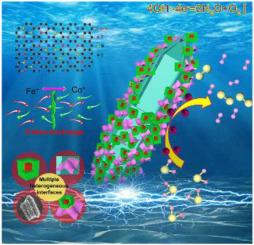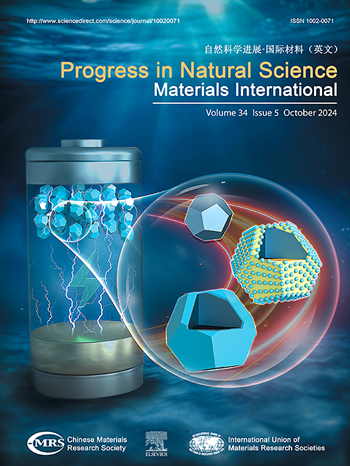Construction of multiple heterogeneous interfaces and oxygen evolution reaction of hollow CoFe bimetallic phosphides derived from MOF template
IF 4.8
2区 材料科学
Q2 MATERIALS SCIENCE, MULTIDISCIPLINARY
Progress in Natural Science: Materials International
Pub Date : 2024-10-01
DOI:10.1016/j.pnsc.2024.09.001
引用次数: 0
Abstract
Rational design of electrocatalysts is the key to achieving sustainable oxygen evolution reaction (OER). The conjugation of metal organic frameworks (MOFs) with different multicomponent materials to precisely construct heterostructures is fascinating but remains a significant challenge due to different interface energies and nucleation kinetics. In this work, hollow multilayer heterogeneous catalyst (CoFeP/CoFeP/NP-C) was constructed using a rigid template sacrifice approach and an ion exchange strategy. By cleverly combining iron-based MOFs (MIL-88A, sacrifice template) nanorods, layered dihydroxides (LDH) nanosheets, and Prussian blue (PB) nancubes to form rich heterojunction and bimetallic phosphide catalysts, and by tuning the reaction kinetics and electron transfer capacities to enrich the active sites, ultimately promoting the intrinsic activity of the catalyst towards OER. Simultaneously, the co-doping of nitrogen and phosphorus in the heterostructure helped to adjust the electronic structure of the heterogeneous catalyst and the conductivity of the matrix, promoting the adsorption and desorption of OER intermediates on the catalyst surface. This work provides a new strategy for designing efficient and stable bimetallic phosphide electrocatalysts.

从 MOF 模板衍生的中空 CoFe 双金属磷化物的多重异质界面构建和氧进化反应
合理设计电催化剂是实现可持续氧进化反应(OER)的关键。将金属有机框架(MOFs)与不同的多组分材料共轭以精确构建异质结构是一项令人着迷的工作,但由于界面能量和成核动力学的不同,这仍然是一项重大挑战。在这项工作中,采用刚性模板牺牲法和离子交换策略构建了中空多层异质催化剂(CoFeP/CoFeP/NP-C)。通过将铁基 MOFs(MIL-88A,牺牲模板)纳米棒、层状二氢氧化物(LDH)纳米片和普鲁士蓝(PB)纳米管巧妙地结合在一起,形成丰富的异质结和双金属磷化物催化剂,并通过调整反应动力学和电子传递能力来丰富活性位点,最终提高了催化剂对 OER 的内在活性。同时,氮和磷在异质结构中的共掺杂有助于调整异质催化剂的电子结构和基质的导电性,促进 OER 中间产物在催化剂表面的吸附和解吸。这项工作为设计高效稳定的双金属磷化物电催化剂提供了一种新策略。
本文章由计算机程序翻译,如有差异,请以英文原文为准。
求助全文
约1分钟内获得全文
求助全文
来源期刊
CiteScore
8.60
自引率
2.10%
发文量
2812
审稿时长
49 days
期刊介绍:
Progress in Natural Science: Materials International provides scientists and engineers throughout the world with a central vehicle for the exchange and dissemination of basic theoretical studies and applied research of advanced materials. The emphasis is placed on original research, both analytical and experimental, which is of permanent interest to engineers and scientists, covering all aspects of new materials and technologies, such as, energy and environmental materials; advanced structural materials; advanced transportation materials, functional and electronic materials; nano-scale and amorphous materials; health and biological materials; materials modeling and simulation; materials characterization; and so on. The latest research achievements and innovative papers in basic theoretical studies and applied research of material science will be carefully selected and promptly reported. Thus, the aim of this Journal is to serve the global materials science and technology community with the latest research findings.
As a service to readers, an international bibliography of recent publications in advanced materials is published bimonthly.

 求助内容:
求助内容: 应助结果提醒方式:
应助结果提醒方式:


